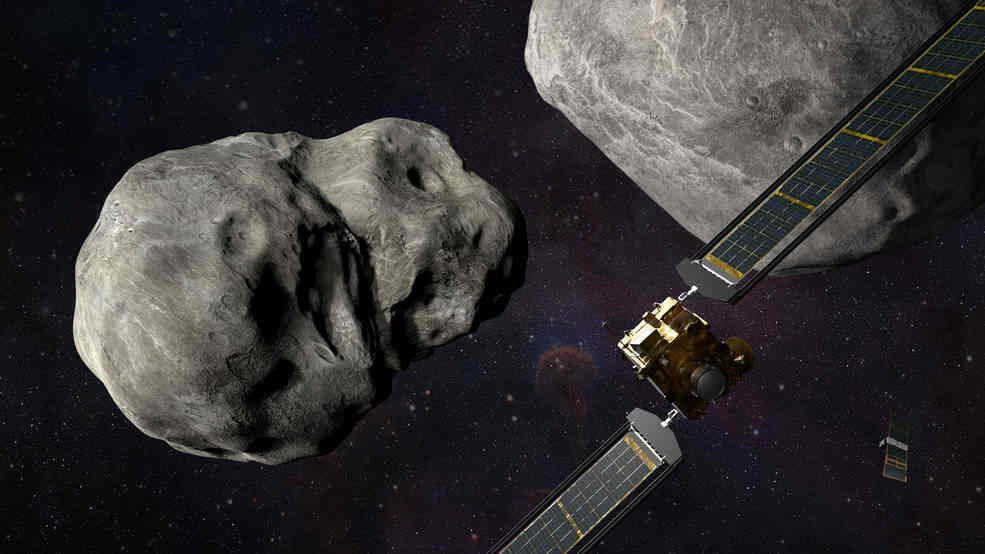Nasa DART Mission | First time diverted the trajectory of an asteroid
Nasa DART mission is an unprecedented test mission worthy of a science fiction novel, which should allow humanity to learn how to protect itself from a possible future threat. Nasa knocked an asteroid off with a test to defense our Earth.
The Nasa Dart mission ship had deliberately crashed into the asteroid Dimorphos, which is the satellite of a larger asteroid named Didymos. The NASA device managed to move it by reducing its orbit by 32 minutes, said the head of the space agency, Bill Nelson, during a press conference.
The probe of the Dart mission launched by NASA has managed to deflect an asteroid from its trajectory, the American space agency announced on Tuesday October 11, 2022. “This is a watershed moment for the defense of the planet and a watershed moment for humanity,” said NASA boss Bill Nelson.
This voluntary collision is a first. Launched on November 23, 2021, NASA’s DART mission was developed to protect Earth from asteroids that could potentially hit it. The 610kg spacecraft is targeting Dimorphos, a 50m wide asteroid. The collision occurred at 23:14 GMT on Sept. 26, 2022.
Mission of “planetary defense” – Nasa DART mission
It will take a few days to a few weeks before scientists can confirm that the trajectory of the asteroid has indeed been altered. They will do this thanks to telescopes on Earth, which will observe the variation in brightness as the small asteroid passes in front and behind the large one.
If the goal remains modest compared to the disaster scenarios of science fiction films like “Armageddon”, this “planetary defense” mission, named DART (Double Asteroid Redirection Test), is the first to test such a technique. It allows NASA to train in case an asteroid threatens to hit Earth one day.
The ship had traveled for ten months since its takeoff in California. To hit a target as small as Dimorphos, the last phase of flight was fully automated, like a self-guided missile.
Three minutes after impact, a shoebox-sized satellite, called LICIACube and released by the spacecraft upriver, was expected to pass about 55 km from the asteroid to capture images of the ejecta.
Read also: Asteroid | Origin, Explanation, Types and Examples | Are we threatened?
DART launch on November 23, 2021
DART’s Impact with Asteroid Dimorphos
Scrutinized closely
The event was also to be observed by the Hubble and James Webb space telescopes, which should be able to detect a bright cloud of dust and thus help to assess the amount of material ejected.
All this should make it possible to better understand the composition of Dimorphos, representative of a population of fairly common asteroids, and therefore to measure the exact effect that this technique – called kinetic impact – can have on them.
The European Hera probe, which is due to take off in 2024, will also closely observe Dimorphos in 2026 to assess the consequences of the impact and calculate, for the first time, the mass of the asteroid.
Read also:Different kinds of meteorites: chondrites, siderites, pallasites…
Nearly 30,000 asteroids in the vicinity of Earth
All this should make it possible to better understand the composition of Dimorphos, representative of a population of fairly common asteroids, and therefore to measure the exact effect that this technique, called “kinetic impact”, can have on them.
Images of Dimorphos, taken shortly before impact, show its surface to be gray and rocky and egg-shaped.
Nearly 30,000 asteroids of all sizes have been cataloged in the vicinity of the Earth: they are called near-Earth objects, that is to say that their orbit crosses that of our planet. Today, none of these known asteroids threatens our planet for the next hundred years, but not all of them have yet been counted: scientists estimate that they know only 40% of asteroids measuring 140 meters or more – those capable of to devastate an entire region.
Hubble Views Aftermath of DART Impact
The unknowns
Asteroids have held surprises for scientists in the past. In 2020, the American probe Osiris-Rex had sunk much more than expected into the surface of the asteroid Bennu. Likewise, the composition of Dimorphos is currently not known.
“If the asteroid responds to the Dart impact in a totally unforeseen way, it could actually lead us to reconsider the extent to which kinetic impact is a generalizable technique,” chief scientist Tom Statler warned last week. of the mission.
Nearly 30,000 asteroids of all sizes have been cataloged in the vicinity of the Earth (they are called near-Earth objects, that is, their orbit crosses that of our planet). Today, none of these known asteroids threaten our planet for the next 100 years. Except that they are not yet all listed.
Those of a kilometer or more have almost all been spotted, according to the scientists. But they feel they don’t have knowledge of only 40% of asteroids measuring 140 meters or more – those capable of devastating an entire region.
“Our most important job is to find” the missing ones, said NASA planetary defense officer Lindley Johnson. The earlier they are detected, the more time the experts will have to put in place a means of defending themselves against them. The Dart mission is a crucial first step in this direction, according to him: “It is a very exciting period… for the history of space, and even the history of humanity”.
Sources: PinterPandai, Nasa, CNN, BBC
Photo credit (main picture): Nasa
Photo descripion: DART’s Small Satellite Companion Takes Flight Ahead of Impact



